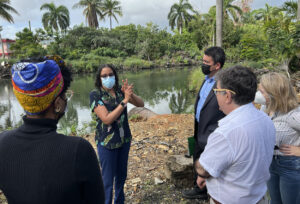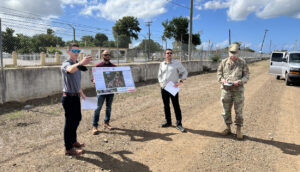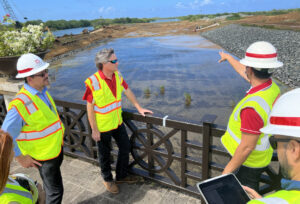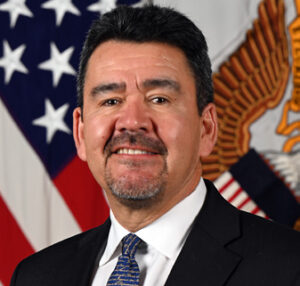With a new infusion of funds from the Bipartisan Infrastructure Law, officially known as the Infrastructure Investment and Jobs Act, the U.S. Army Corps of Engineers is putting boots on the ground to complete a backlog of projects and make new investments in everything from improving the nation’s ports and inland waterways to making communities more resilient to climate change. In this interview, Municipal Water Leader speaks with Mike Connor, the new assistant secretary of the army for civil works, about implementing these and other top priorities.
Municipal Water Leader: Please tell us about your background and how you came to be in your current position.
Assistant Secretary Connor: I am a chemical engineer by training. I started my career at General Electric, where I worked in manufacturing and power generation. I was tired of the lawyers always telling me what to do, so I went back to law school at the University of Colorado and studied environmental law. I started my government career with the U.S. Department of the Interior, where I served in the solicitor’s office and directed the Indian Water Rights Office. After that, I served as counsel to the United States Senate Committee on Energy and Natural Resources. There, I led the Water and Power Subcommittee, oversaw the Bureau of Reclamation and the U.S. Geological Survey, and worked on a lot of Native American issues, which I always had an interest in, being a tribal member myself. Then, at the start of the Obama administration, I was asked by Secretary of the Interior Ken Salazar to run Reclamation, and I led the agency’s mission to manage, develop, and protect water and related resources. Later in the Obama administration, I served as the deputy secretary of the interior, where I was the chief operating officer. During my tenure at Interior, I worked closely with the Army Corps, coordinating operations, working together on risk-management strategies, and trying to integrate the effects that climate change was having on water resources into our operations. Prior to my confirmation as assistant secretary of the army for civil works, I worked in private practice for the first time in my career as a partner at the WilmerHale law firm. My portfolio included natural resources, renewable energy development, environmental compliance, and Native American law.

Municipal Water Leader: Would you give us a brief introduction to the Army Corps?
Assistant Secretary Connor: The Office of Assistant Secretary of the Army for Civil Works establishes policy direction for and supervises U.S. Department of the Army functions relating to all aspects of the Army Corps’ civil works program. The Army Corps is a nationwide water resource manager involved historically in flood-control risk management. We are also responsible for coastal protection, aquatic ecosystem restoration, and hydropower operations involved in water supply. The Army Corps is perhaps most visible in managing the water resources regulatory programs under the Clean Water Act and the Rivers and Harbors Act. The Army Corps maintains the nation’s ports and harbors as well as our channels, locks, dams, and other facilities. Navigation was the Army Corps’ earliest civil works mission. Today, the Army Corps supports the nation’s supply chain by maintaining our ability to ship cargo and move goods, both along the coast and inland.
Municipal Water Leader: Would you describe your role as assistant secretary of the army for civil works?
Assistant Secretary Connor: My primary role as the assistant secretary is to develop and implement policy and allocate resources to execute programs in the key mission areas that I just mentioned. I serve as the principal advisor to the secretary of the army on all matters related to the army civil works program. Civil Works is responsible for the conservation and development of the nation’s water and wetland resources, flood control, navigation, and shore protection, all of which are important aspects of the president’s climate resilience priorities.
Municipal Water Leader: What are the top issues and priorities for the Army Corps today?
Assistant Secretary Connor: I see the role of the Army Corps as implementing and supporting the administration’s priorities. One of the things that President Biden has highlighted is economic recovery and growth. As I mentioned, the Army Corps plays a key role in supporting economic activity and commerce in this country—maintaining navigable waterways and maintaining our capacity to get ships in and out of our ports. That focus is going to continue to be a priority.
The administration is also committed to climate resilience and adaptation, and the Army Corps plays a central role in implementing related policies. We do flood and coastal risk management to deal with the growing risks to our river and coastal communities posed by extreme weather events, rising sea levels, and increased storm surges. The Army Corps also plays a role in addressing another issue related to climate change, namely our increasingly longer and deeper droughts. Since 1981, the Army Corps has published drought contingency plans for each water resource project or system of projects that has controlled reservoir storage. These plans anticipate the effects of climate change on the frequency, duration, and spatial extent of drought in the United States and incorporate new technologies and drought monitoring methods to support sustainable water management.
Another administration priority is working on environmental justice and lifting up communities that have historically been marginalized. When you look at our Bipartisan Infrastructure Law investments, we chose a lot of projects that directly benefit historically disadvantaged communities, including tribes and communities that are lower on the economic scale.
We also have to continue to strengthen and build our workforce. With the investments that Congress is providing to carry out this work, we’re doing a lot of hiring. We always want to be focused on executing our responsibilities as efficiently and as innovatively as possible.
Municipal Water Leader: You touched on the Bipartisan Infrastructure Law. What is the Army Corps’ plan for getting that infrastructure money out the door?

Assistant Secretary Connor: Congress gave a tight deadline when the infrastructure bill passed in November 2021. We had 60 days to develop a work plan for the initial fiscal year 2022 investments. We made the first round of selections to get that money out the door for fiscal year 2022, incorporating the priorities I mentioned earlier. We anticipate additional allocations in the near future in addition to the typical budget process.
The infrastructure law has given a great lift to a lot of important administration priorities. We were able to invest in some projects that were hard to move forward because of the significant funding need, such as reinvestments and the building of new capacity in our inland waterway system, important work within the nation’s ports, and the restoration of aquatic ecosystems. The ability to invest $1.1 billion in the Everglades restoration program is significant. We’re also doing some innovative work in the Chesapeake Bay—rebuilding and restoring island habitat using dredged material. And we’re doing some work to protect tribal lands from coastal erosion and enhance cultural resources. It’s an impressive set of investments across the board. Right now, we’re making decisions, announcing them, and moving forward with on-the-ground work to finalize designs and move into construction. We’re also advancing construction for projects that are already underway, such as work on the Soo Locks in Michigan, an incredibly important facility for delivering iron ore and steel in the Great Lakes region. Leading the decisionmaking process for the Bipartisan Infrastructure

management protection for thousands of people affected by increasingly dangerous storm flooding.
Law investments is the most significant item I’ve spent my time on during my first several months in office.
Municipal Water Leader: If people have projects that might benefit from some of these funds, what is the best way for them to communicate their needs to the Army Corps?
Assistant Secretary Connor: From an investment standpoint, we don’t have to think long and hard about where the needs are across the nation. Coming into this, the Bipartisan Infrastructure Law provided $17.1 billion to the Army Corps. The Army Corps has a backlog of about $100 billion worth of authorized projects and activities. Not all of them are current, but there’s a long line of worthy projects that have been authorized by Congress, projects for which communities have gathered the local resources needed to meet the cost-share requirements. That’s really been the focus of most of the construction activities—trying to complete several of those long-authorized projects and pushing forward those that really highlight the administration’s priorities. Communities have been actively working with us to identify the need for investigations into the new risks driven by climate change. We’re working on some new strategies to protect our coasts against sea-level rise, including integrating natural and nature-based infrastructure.
Getting back to environmental justice for marginalized communities, we are going to be doing more outreach to tribal communities and others who have not formerly worked with the Army Corps in the past. We plan to have more interactive dialogue about how the Army Corps might help them through programs such as Planning Assistance to States and Floodplain Management Services. We need to look at how we develop projects and how we recommend those projects for approval, because the traditional cost-benefit formulas may not adequately capture the full picture of benefits to and effects on local communities.
Municipal Water Leader: Would you comment on the Army Corps’ work in developing the new Waters of the United States rule?
Assistant Secretary Connor: Amid the litigation associated with the Navigable Waters Protection rule, the Army Corps and the public need some level of certainty on how permitting that relates to Waters of the United States will work, so we have gone back to pre-2015 regulations and guidance with updates to incorporate guidance from recent Supreme Court opinions. I think there’s still a need for that, notwithstanding the fact that the Supreme Court has taken the Sackett case, which is likely to be argued in the fall. We are unlikely to get a decision from the Supreme Court for some time, but we need to continue to operate, to run our regulatory program, and to issue permits. That weighs in favor of finishing our current rulemaking process. We don’t know what the Supreme Court is going to do, and its decision could very well be consistent with a pre-2015 approach. For now, my perspective is that we need to finish our work.
Municipal Water Leader: Given your experience leading Reclamation and your deep familiarity with the agency, do you expect to see an increase in cooperation between the Army Corps and Reclamation?
Assistant Secretary Connor: Absolutely. Given the challenges we face and the effects of climate change, I think it’s essential that we work not just with Reclamation but with state water resource agencies. I think that all of us in the water community—at the federal, state, local, and tribal government levels—have expected some of the changes that we’re seeing with respect to widespread droughts, change in snowpack levels, and more-frequent extreme weather events, but I think the pace of those changes is surprising. The states are doing a lot of their own development, as are utilities at the local level, and the tribes are getting more sophisticated in how they identify their needs and develop strategies to address them. This whole-of-government approach is not just a good idea that is going to create efficiencies, but it’s critical given the challenges that we now face in managing our water resources. So yes, there will be more interaction and cooperation, because we’ve been moving in that direction for a while, and I think the demands on the landscape now require it.

Municipal Water Leader: What is your vision for the future?
Assistant Secretary Connor: My vision for the future is driven by a sense of urgency. I’d like the Army Corps, a capable and talented organization, to be innovative in developing new strategies and to build climate resilience to better protect and prepare communities for some of the challenges that they’re facing. We need to take advantage of nature-based infrastructure and figure out how we can bring multiple benefits to our projects so that we’re not just doing flood risk and coastal storm management but are also helping to further environmental restoration and even augment water supply where we can.
I still believe that the Army Corps is the preeminent engineering organization in the country. It has long led efforts that have helped transform the country. We’re in an era where those new challenges are coming at us quickly, and we need to do more of that and pick up the pace.
Mike Connor is the assistant secretary of the army for civil works. His office can be contacted at usarmy.pentagon.hqda-asa-cw.mbx.asa-cw-reporting@army.mil.

